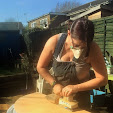I'm busy with the first stage of a project for a client at the moment. This phase involves transferring a printed managers' guide to employment practice online. Although my field is learning, as a website, this first phase is not directly learning-focused. However, it is knowledge-focused in that it affords the user JIT access to the current company policies and procedures on dealing with staffing matters.
During the scoping phase, the client asked that the material be divided into three sections: Policies, Procedures and Guidance. Policies, of course, would lay out the company stance on various issues. Procedures would provide information on how to observe the company policy in practice. Guidance would offer hints and tips, flowcharts and so on to support the manager through unfamiliar processes.
The website was constructed. The site architect decided on Etomite. He could tell you why. Me? I know nothing! I just trust him to know. He usually does.
It looked good and worked fine. The HR professionals who were testing it sang its praises. But something was not quite right. Don't get me wrong - this wasn't an Etomite problem. The site architect was not comfortable about the fundamental structure of the site. Would a manager dealing with a grievance for the first time, lacking the HR training and experience of the testers, know whether to look under policies or procedures (or even guidance) first? The site had a search facility, but to conduct a search on "grievance" would return too many hits to be helpful. Hmm. What to do. He felt that the architecture should be based on the issues arising: grievance, discipline, recruitment, flexible working, etc. He raised this point in various ways in a few meetings with the client, but she didn't bite.
Then three things happened in quick succession:
- My colleague showed the site to someone whose views he respects, who made exactly the same suggestion about the architecture that he had had a growing conviction about.
- The client sent in a list of amendments grouped by "issue": absence management, disciplinary, equal pay, etc. rather than as Policy, Procedure and Guidance. On a subconscious level, she obviously agreed.
- The client asked for the order of the related pages list to be changed... for the second time. She wasn't happy with the system by which users navigated through the site, but she couldn't put her finger on what was bothering her.
Was I nuts? I know nothing about building websites. However, the chap who built the original site showed me how to edit existing pages, add new ones and delete those no longer required. Sheesh! It's a doddle. Even I could do it. It is a bit slow going, since it means working online all the time, but that I can handle.
Next time I see my colleague the architect, he will show me how to use key words and such. I know I have my work cut out for me, some of which is deadly dull and repetitive, but wahey - it's easy... so far!
So the basic structure of the site is being reworked. However, as a famous politician from my homeland once said: time are few. I'd best get cracking then!


2 comments:
Wow! That is great! I'm very impressed!
I too believe websites should be intuitive. Too often we lay out websites like the old three ring binders on our shelves. We look in the binder and see what the tabs are named and that is how we lay out the website. Big mistake.
You've hit on a major usability issue here that I found when I did a lot of site design. It is better to watch someone use a prototype than it is to have them talk about what they want!
P.S. I prayed for your allergies today!
Yup - it's all about UAT at the end of the day, no matter what the product is. Usually, I stick to my territory, but I had to step out of my comfort zone to fulfill my commitment to my client to my standards.
Post a Comment